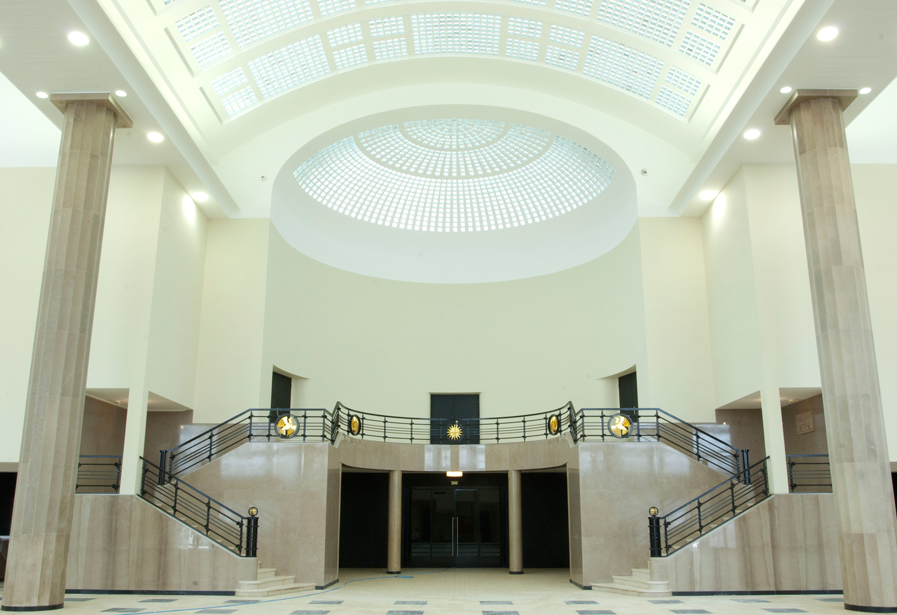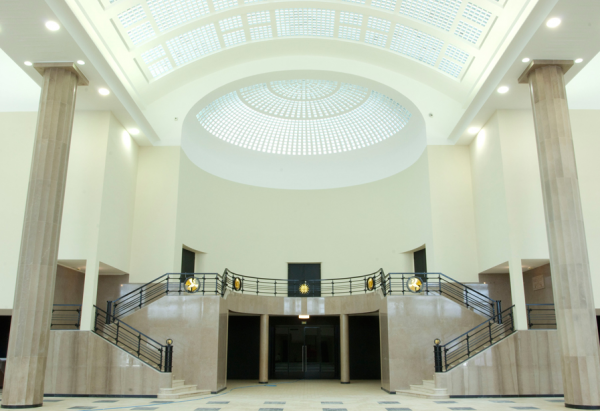The “Salle des Huit Colonnes” was restored thanks to historic photos–it was designed by architect Georges Labro for the 1937 Universal Exhibition. It features a checkered black and white floor and a domed glass roof. Swiss watch manufacturer Bell & Ross has sponsored the re-installation of a monumental clock, where each of the twelve points on the dial is a smaller clock indicating a time zone.
At press time, two aircraft were still to be displayed in the gallery. A Morane G, similar to the one Roland Garros flew when it crossed the Mediterranean Sea in 1913, was to neighbor a Blériot XI-2 “Looping.” Adolpe Pégoud performed the first loop ever on the latter type. The hall is eventually to become the museum’s entrance area.
It used to be the main hall of the terminal, welcoming both departing and arriving passengers. Le Bourget was a commercial aviation airport from the 1930s to the 1970s. Paris Orly and then Paris Charles-de-Gaulle airports replaced it. Le Bourget began to be seen as old-fashioned. This is when the museum started to be able to take over unused buildings.
“At the time, nobody was realizing how valuable they were,” managing director Catherine Maunoury told AIN. Some of its most beautiful architectural art, such as the glass roofs, were hidden. This conception has changed and visitors are increasingly seeing the improvement first hand. Moreover, “the Museum benefits from a location that is a great combination–it is historic, as the military began using it as an airfield during World War I and Charles Lindbergh landed here after his transatlantic flight in 1927, it is the venue for the world’s largest air show and it is Europe’s number-one business aviation airport,” Maunoury went on.
Maunoury likens the June 3 inauguration to both an arrival and a departure. These two words (arrivée and départ in French) are being displayed again in 1930s-style letters on the terminal’s walls. Indeed, the “Salle des Huit Colonnes” is the first achievement in a relatively long project. The next steps in the project are the façades, both on the runway side–where the façade evokes an ocean liner–and the town’s side, where the clean lines rather remind of an airplane. The rest of the terminal’s interior will be restored, too. The end of the works is planned for 2015.
In fact, the actual starting point of the restoration project was the Paris Air Show in 2011. Then, Gérard Longuet, who was the French minister of defense, paid a visit as the authority in charge of the museum. “Before he came, he was rather ready to tell us we had too many aircraft but when he saw the site, he changed his mind,” Maunoury recalled. This was how a €20 million ($26 million) grant was awarded. Since then, current minister Jean-Yves Le Drian has expressed continued support.
An additional €5 million ($6.5 million) came from Gifas, the French aerospace industry lobbying association. The amount is being used to improve the restoration workshops in Dugny. Some 40 technicians and craftsmen perform thorough repair jobs on vintage aircraft there.

























